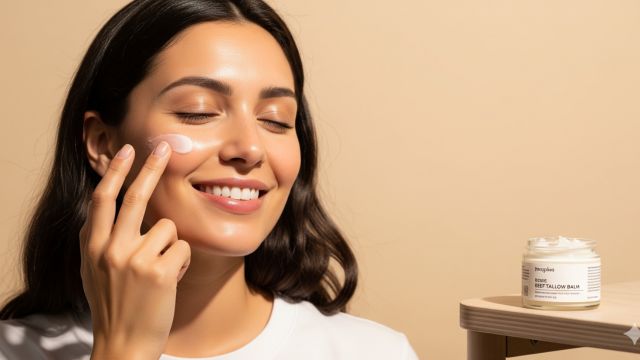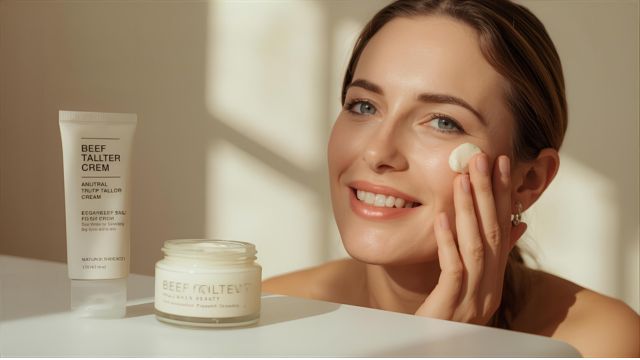When I first heard people on TikTok talk about putting beef tallow on their face, I laughed. I mean—beef fat as skincare? It sounded more like a kitchen experiment gone wrong. But the more I dug in, the more I realized this isn’t just hype. In fact, beef tallow for skin has a long history, and now it’s making a serious comeback.
At HBMAG, we’ve been keeping an eye on natural skincare trends, and this one stood out. People are frustrated with complicated routines, chemical-heavy creams, and high price tags. Beef tallow, on the other hand, promises something simple: a deeply moisturizing, natural alternative that our grandparents probably used without giving it a second thought.
What Exactly Is Beef Tallow?
Beef tallow is rendered beef fat, usually taken from the kidney and loins (that part is called suet). When melted down and purified, it turns into a smooth, creamy balm. For generations, people used it to cook, make candles, and yes—even as a moisturizer before fancy skincare brands existed.
What’s interesting is that beef tallow is biologically similar to the oils our skin naturally produces. That’s one reason fans say it absorbs better than plant oils, without leaving a sticky film.
Beef Tallow Benefits for Skin
In our research, a few key benefits kept popping up:
- Deep hydration – People with dry, cracked, or flaky skin say beef tallow locks in moisture for hours.
- Nutrient-rich – It contains vitamins A, D, E, and K, plus fatty acids that support the skin barrier.
- Soothing effect – Some users claim it helps calm redness, irritation, and even eczema patches.
- Anti-aging buzz – Fans argue it reduces fine lines by keeping skin plump and nourished.
Now, these are mostly anecdotal. There aren’t a ton of clinical studies yet, but the overlap between beef tallow’s fatty acids and our own sebum does make sense biologically.
Risks and Side Effects
Let’s be real—beef tallow isn’t for everyone.
- If you have acne-prone or oily skin, it might clog pores. (Yes, the dreaded “comedogenic” factor is debated, but it’s worth testing on a small patch first.)
- Ethical and dietary concerns – If you’re vegan or just not comfortable with animal-based skincare, this won’t be for you.
- Scent and texture – Unless it’s purified well, beef tallow can have a slight meaty smell. Some find that off-putting.
Bottom line: test it first and don’t ditch your dermatologist-approved products without checking. For a more easy approach to skin care, you can even use Prime Biome, which comes in an easy-to-consume gummy form and targets gut health for improving skin.
How to Use Beef Tallow for Skin Care

From what we’ve seen, people use beef tallow in a few different ways:
- As a moisturizer – Rub a pea-sized amount between your hands and apply like a face cream.
- As a balm – Works for lips, elbows, or dry cuticles.
- DIY tallow cream – Many mix it with essential oils or blend it with shea butter for a softer texture.
👉 Tip: You can buy beef tallow balm online (Etsy is full of small-batch sellers), or make your own by rendering fat from a butcher.
Beef Tallow vs. Other Natural Moisturizers
Here’s where things get interesting. Compared to popular natural options:
- Shea butter – Rich and hydrating, but can feel heavy.
- Coconut oil – Absorbs fast, but clogs pores for many.
- Lanolin – Very effective but comes from sheep’s wool, which some avoid.
Beef tallow sits somewhere in the middle: deeply moisturizing, but often lighter on the skin than shea or coconut oil.
Why Is Beef Tallow Trending Now?
Honestly, it comes down to frustration with modern skincare. People want fewer steps, less jargon, and more results. The #tallowskincare hashtag has racked up millions of views because it feels “ancestral” and authentic.
Readers also told us they like the DIY angle—knowing exactly what’s in their product. In a time when everyone is suspicious of long ingredient lists, tallow wins points for being one simple, recognizable thing.
FAQs About Beef Tallow for Skin
Is beef tallow good for skin?
Yes—for many people with dry or sensitive skin, it’s an effective natural moisturizer.
Can you put beef tallow on your face every day?
You can, but start slow. Apply a small amount at night and see how your skin reacts.
Is beef tallow comedogenic?
It depends. Some find it pore-clogging, while others say it actually balances their skin.
Where can I buy beef tallow balm?
Etsy, natural skincare brands, or even local butchers, if you want to make your own.
Final Take: Should You Try It?
After diving into the research, I’d say beef tallow for skin is worth exploring—especially if you struggle with dryness and want a more natural, back-to-basics option. But it’s not a miracle cream for everyone. Patch test, see how your skin responds, and remember that sometimes the simplest solutions really are the most powerful.
At HBMAG, we’ll keep watching how this trend develops. For now, beef tallow is more than just a TikTok fad—it’s proof that old remedies sometimes earn their way back into the spotlight.
About The Author
We’re a small team of health writers, researchers, and wellness reviewers behind Healthy Beginnings Magazine. We spend our days digging into supplements, fact-checking claims, and testing what actually works—so you don’t have to. Our goal is simple: give you clear, honest, and useful information to help you make better health choices without all the hype.
ADVERTISEMENT


Recent Posts